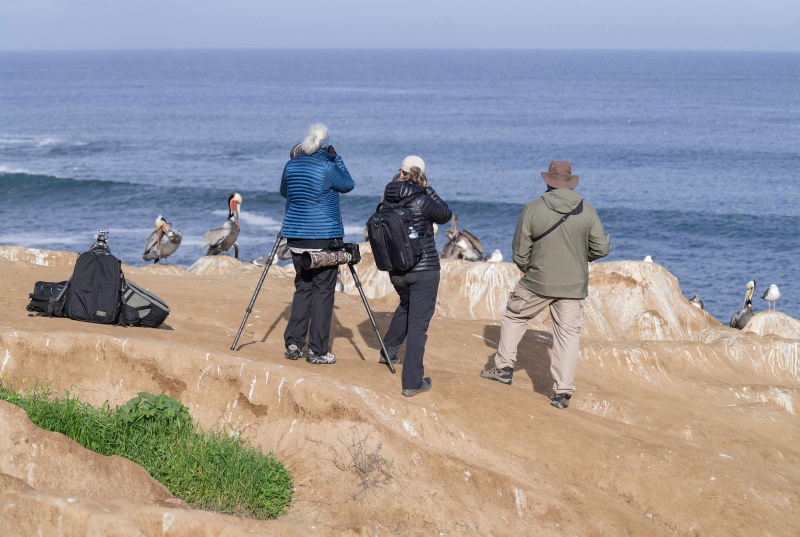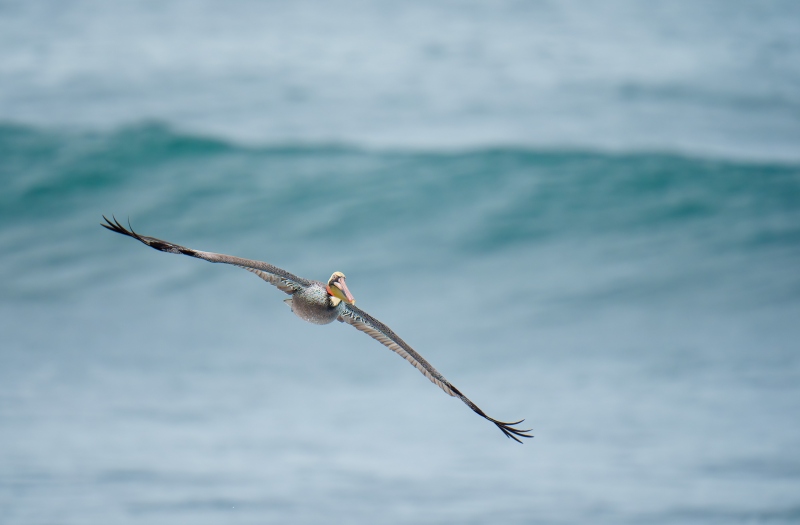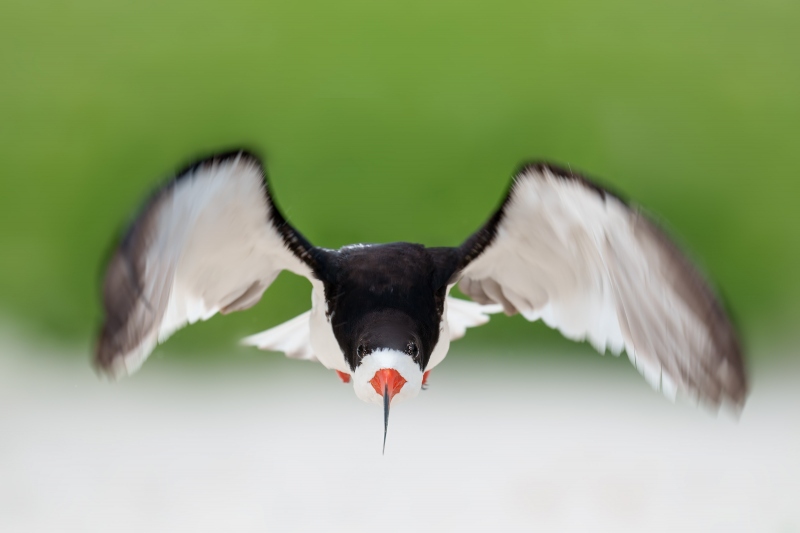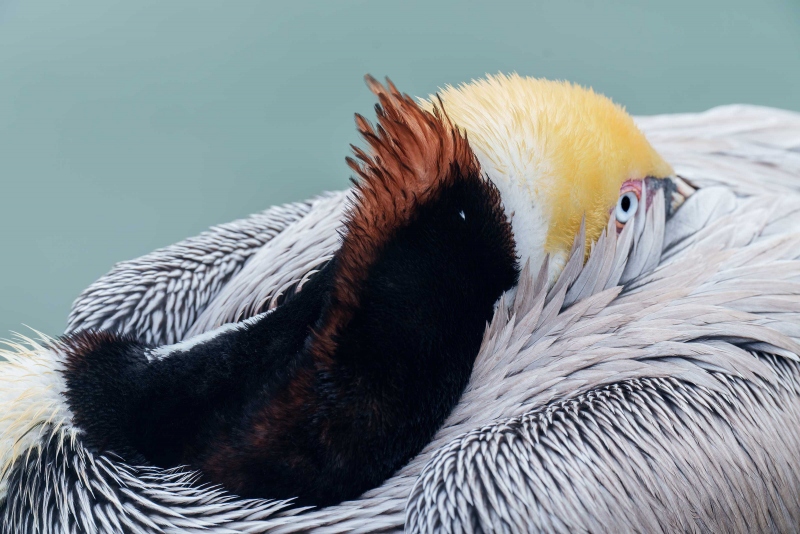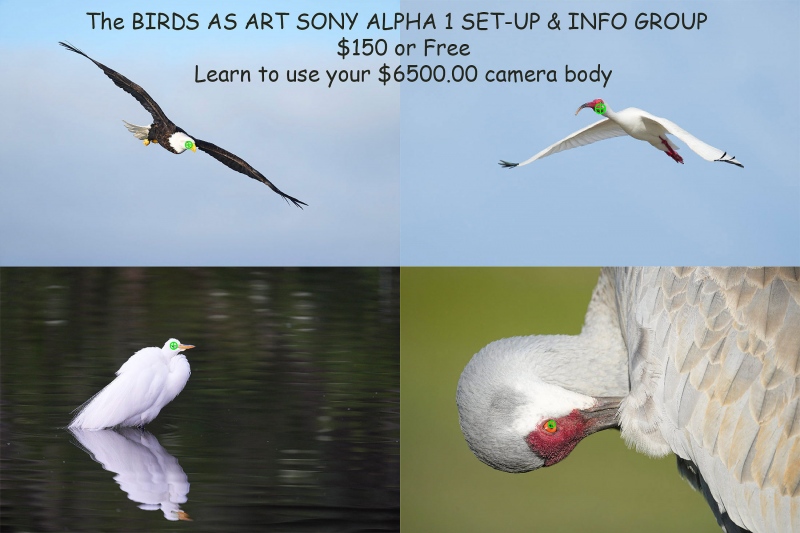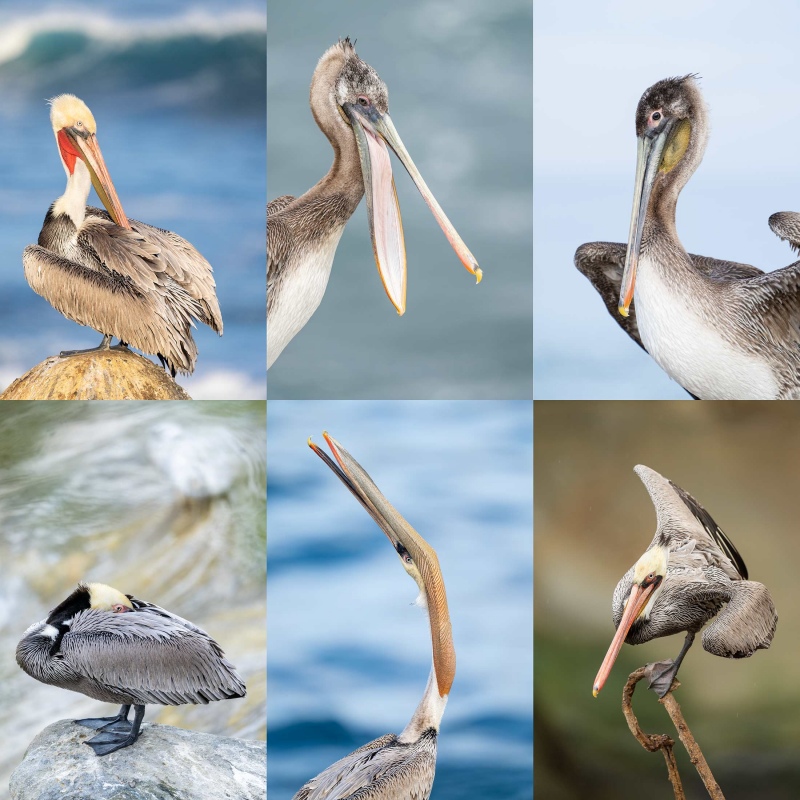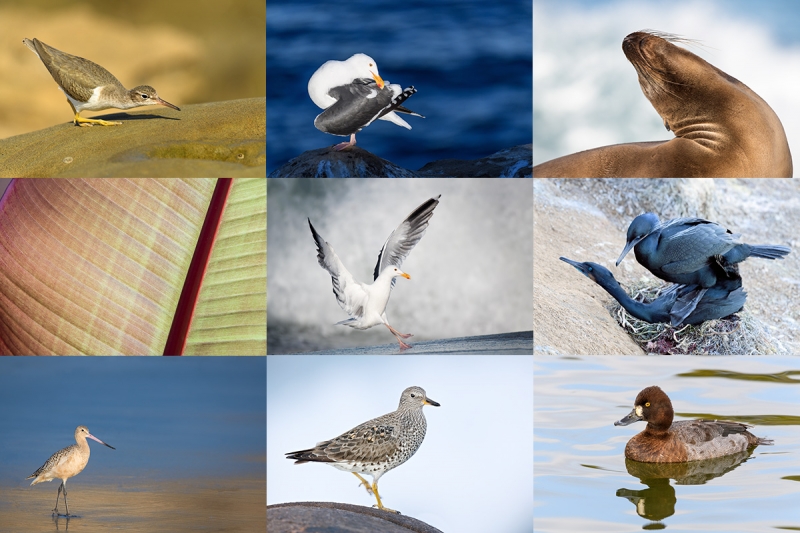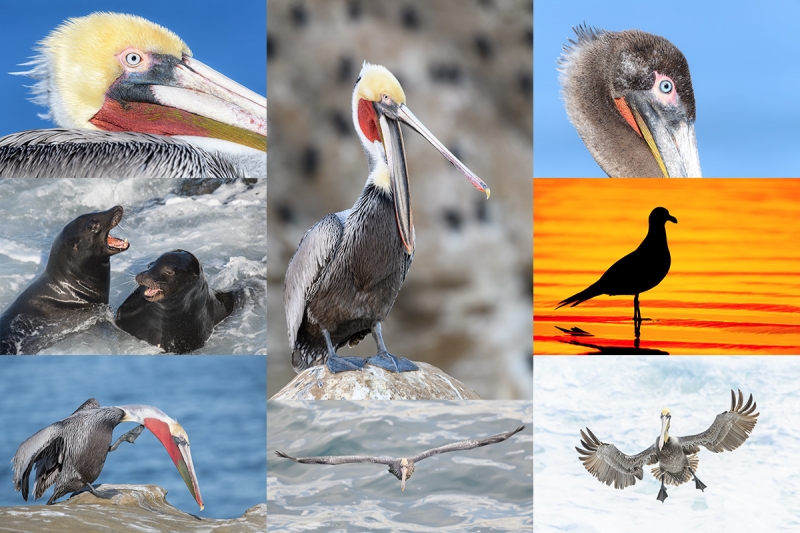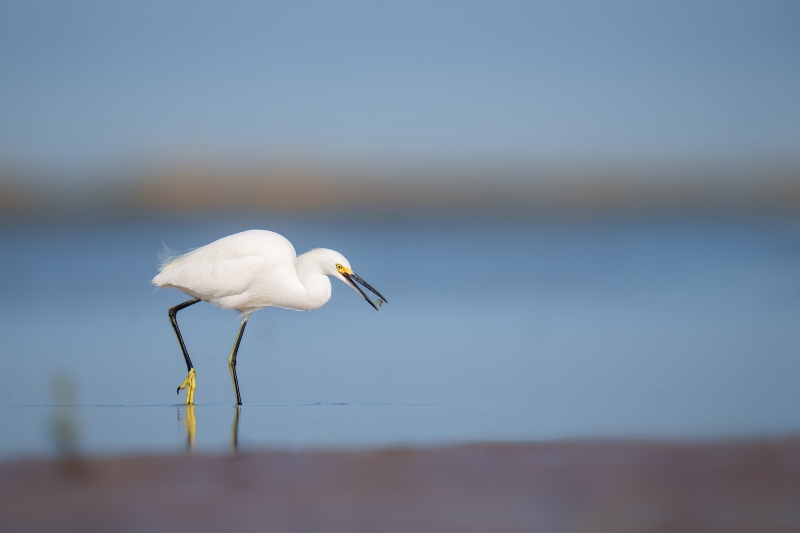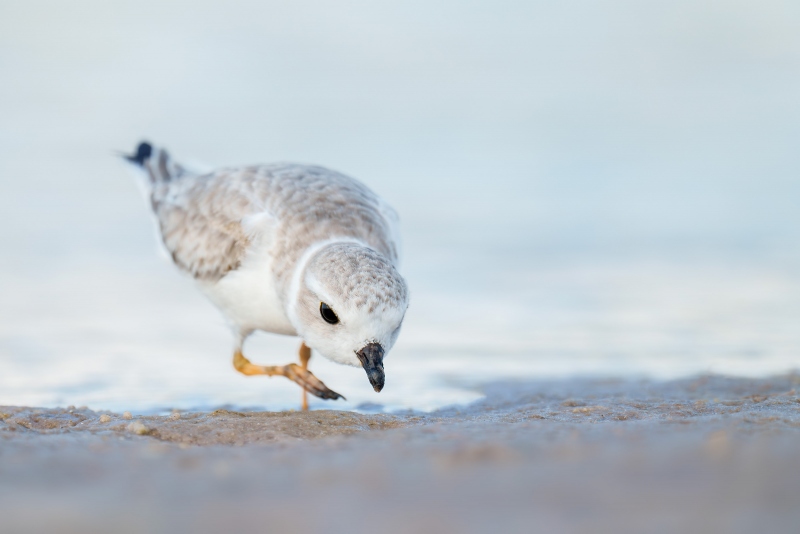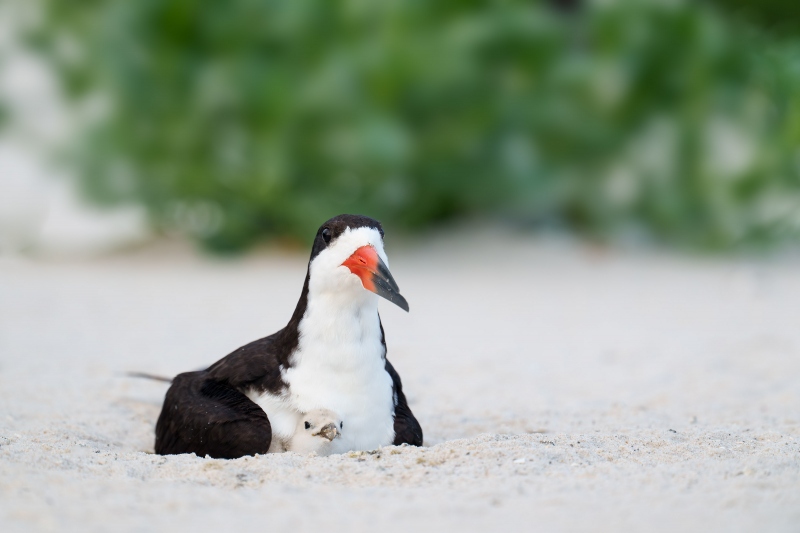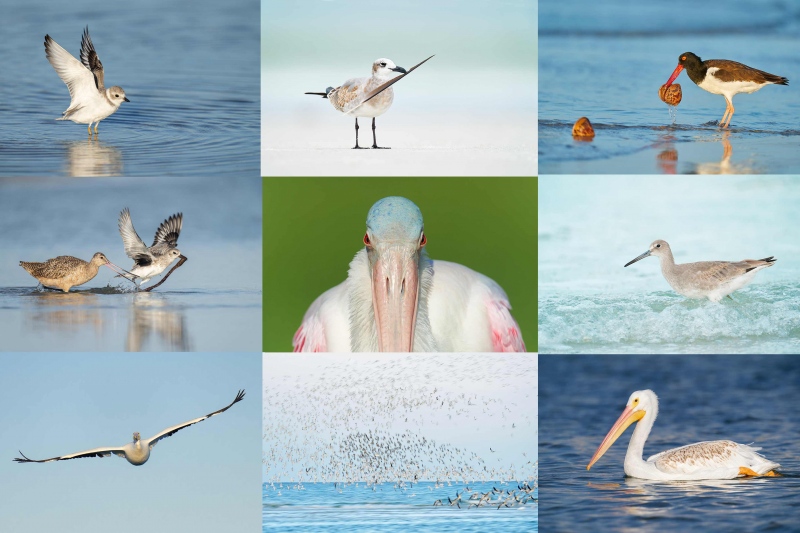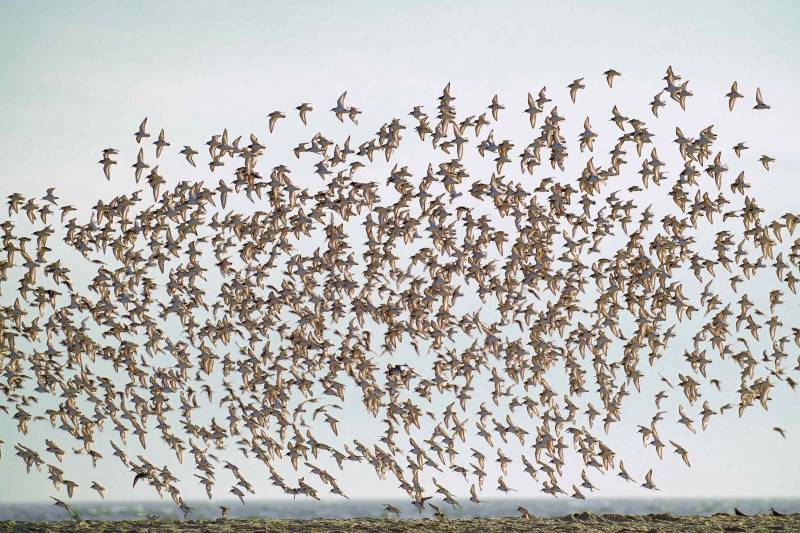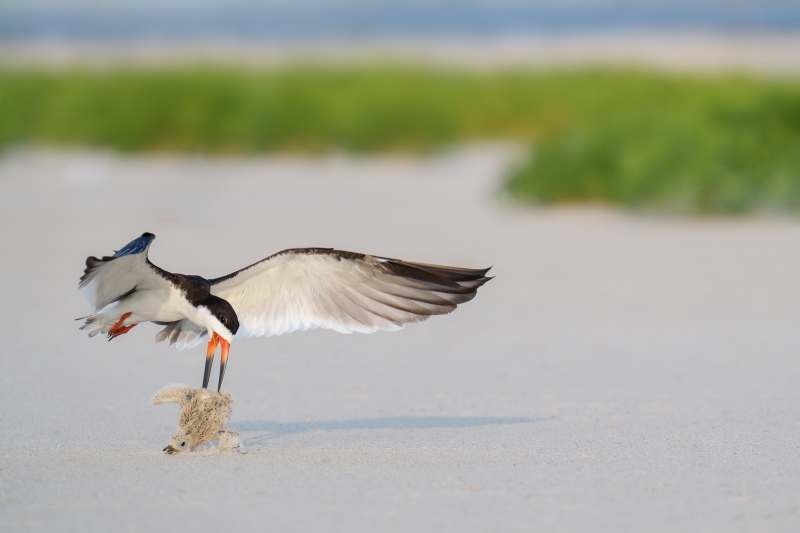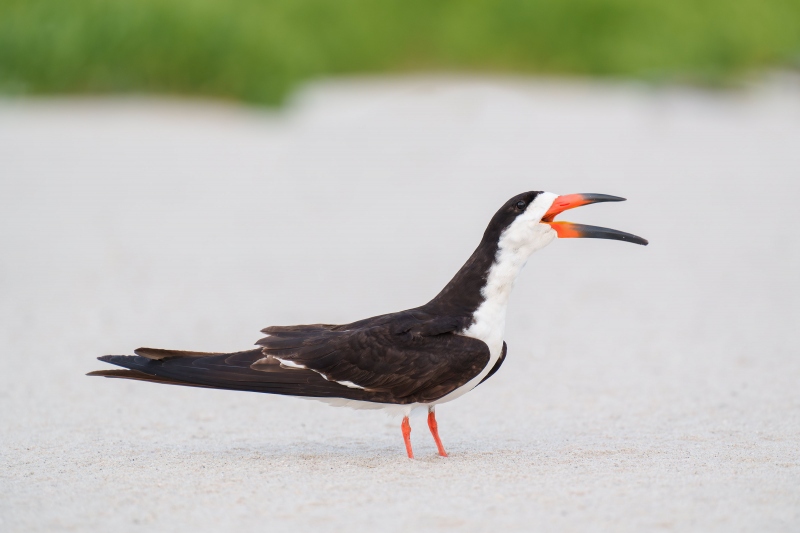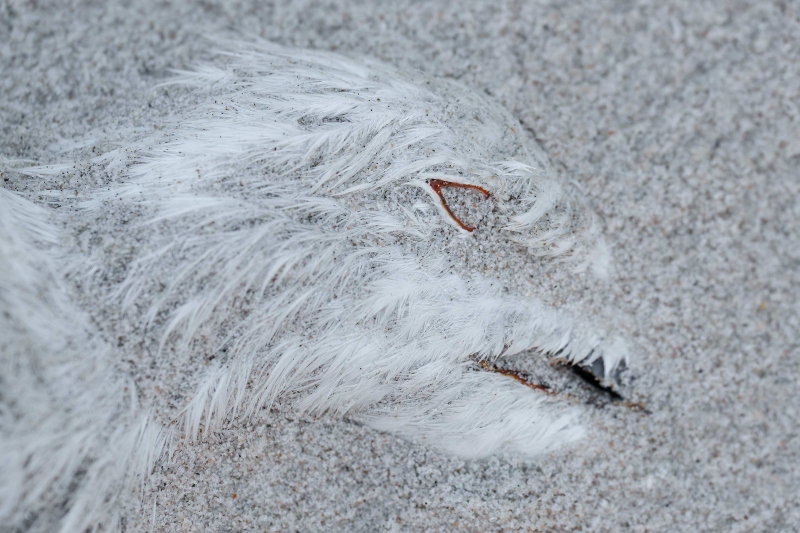August 21st, 2023 What’s Up?
I just got home from Long Island and am getting ready for the 2023 Galapagos Photo-Cruise of a Lifetime. The good news is that the required clothing for the latter is pretty much identical to that of the former. And the gear is quite similar too; I will be trading out the 600mm f/4 that was vital at Nickerson Beach for the faster, lighter, easier to handhold 400mm f/2.8. If you are interested in joining me in the Galapagos in August 2024, please get in touch via e-mail. Remember that you only live once.
Arash Hazeghi sent me the final PDF for the new flight guide. Its publication will be announced here in the next blog post.
Today is Monday 21 August 2023. Wherever you are and whatever you are doing, I hope that you too have a great day.
Please remember to use the B&H and Amazon links that are found on most blog pages and to use the BIRDSASART discount code at checkout when purchasing your new gear from Bedfords to get 3% back on your credit card and enjoy free second-day air FedEx. Please, also, consider joining a BAA IPT. You will be amazed at how much you will learn!
You can find some great photo accessories (and necessities, like surf booties!) on Amazon by clicking on the Stuff tab on the orange/yellow menu bar above. On a related note, it would be extremely helpful if blog-folks who, like me, spend too much money on Amazon, would get in the habit of clicking on the Amazon logo link on the right side of each blog post when they shop online. As you might expect, doing so will not cost you a single penny, but would be appreciated tremendously by yours truly. And doing so works seamlessly with your Amazon Prime account.
If an item — a Delkin flash card, or a tripod head — for example, that is available from B&H and/or Bedfords, is also available in the BAA Online Store, it would be great, and greatly appreciated, if you would opt to purchase from us. We will match any price. Please remember also to use my B&H affiliate links or to earn 3% cash back at Bedfords by using the BIRDSASART discount code at checkout for your major gear purchases. Doing either often earns you free guides and/or discounts. And always earns my great appreciation.
Registration is Free!
In New York City at The Javits Center
Easily Accessible to anyone in The Tri-State Area
A Celebration of 50 Years of Creativity Through Photo, Video and Audio
Click here to learn more or to register.
More than 100 World Class Speakers
Portfolio Reviews
Photo Walks
Photo & Video Experiences
Tri-State Accessibility
Audio Experience
Contests and Prizes
Learn New Skills
Show Specials on Gear
Network with the Premier Photographers, and Videographers
The Fact$ of Life
The market for editorial sales of natural history images has virtually disappeared. The incomes of the world’s top stock photographers are down by at least 90%. Like me, many depend on income from photo trips, the sale of educational materials, and income from this or that affiliate program.
In 2001, BAA sold the publication rights to images for nearly one-quarter million US dollars. That amount dropped to about $20,000 by 2011, and in 2017, to slightly more than $2,000.00. We’ve stopped counting. IPTs used to fill within days. Now I am happy to go with one or two folks, but I’d much rather have you along. And so it goes. In 2009, I turned to creating educational blog posts, now to the tune of 4072! Yes, 4072 educational blog posts. Please, therefore, remember to use either my B&H or Bedfords affiliate links for your major purposes. It will not cost you one cent to do either.
B&H
Many folks have written recently stating that they purchased a Sony a1 from B&H and would like their free membership in the Sony 1 Info and Updates Group, a $150.00 value. When I check my affiliate account, their orders have not been there. When I let them know that they get credit for B&H purchases only if they use one of the many B&H affiliate links on the blog or begin their searches with this link, they are always disappointed. If in doubt, please contact me via e-mail and request a BH link. I am always glad to help and to guide you to the right gear.
B&H Simplified
To ensure that I get credit for your B&H purchases, you can always click here. The tracking is invisible but greatly appreciated. And, you can use your PayBoo card. You must use the website to order. Thanking me for the past 4000 educational blog posts could not be any easier and will not cost you one penny. Please shoot me your B&H receipt for major purchases.
Bedfords Simplified
Click here to start your search. Choose standard shipping, and when you get to the payment page, enter BIRDSASART in the discount code box and hit apply. You will automatically be upgraded to free second day air Fed-Ex and receive 3% cash back on your credit card once your order ships. Either is greatly appreciated by yours truly.
Money Saving Reminder
Many have learned that if you need a hot photo item that is out of stock at B&H and would like to enjoy getting 3% back on your credit card along with free 2nd Day Air Fed-Ex Air shipping, your best bet is to click here, place an order with Bedfords, and enter the coupon code BIRDSASART at checkout. If an item is out of stock, contact Steve Elkins via e-mail or on his cell phone at (479) 381-2592 (Central time). Be sure to mention the BIRDSASART coupon code and check the box for Free Shipping. That will automatically upgrade to free 2nd Day Air Fed-Ex. Steve has been great at getting folks the hot items that are out of stock at B&H and everywhere else. The waitlists at the big stores can be a year or longer for the hard-to-get items. Steve will surely get you your gear long before that. For the past year, he has been helping BAA Blog folks get their hands on items like the SONY a 1, the SONY 200-600 G OSS lens, the Canon EOS R5, the Canon RF 100-500mm lens, and the Nikon 500mm PF. Steve is personable, helpful, and eager to please.
Important Note
As an Amazon Associate, I earn a small percentage when you purchase from Amazon after using any of the Amazon links on the blog (including the logo-link on the right side of each blog post page). My affiliate link works fine with Amazon Prime and using it will not cost you a single cent. Huge thanks, BTW 🙂


Gear Questions and Advice
Too many folks attending BAA IPTs and dozens of photographers whom I see in the field and on BPN, are — out of ignorance — using the wrong gear, especially when it comes to tripods and more especially, tripod heads. And the same is true in spades when ordering new camera bodies or lenses. My advice will often save you some serious money and may help you avoid making a seriously bad choice. Please know that I am always glad to answer your gear questions via e-mail. If you are desperate, you can try me on my cell at 863-221-2372. Please leave a message and shoot me a text if I do not pick up.
|
|
|
This image was created on 25 January at La Jolla, CA on a San Diego IPT. I used the handheld Sony FE 70-200mm f/2.8 GM OSS II lens with the Sony FE 1.4x Teleconverter (at 98mm) and The One, the Sony Alpha 1 Mirrorless Digital Camera.. The exposure was determined via Zebras. ISO 320: 1/2000 sec. at f/4.5 (stopped down 1/3-stop) in Manual mode. AWB at 9:43:03am on a sunny morning.
Tracking: Spot S AF/C performed perfectly. Click on the image to enjoy a high-res version.
Image #1: Bird photographers on the pelican point
t year
|
This Could Be You!
Join me on a 2024 San Diego Instructional Photo Tour (IPT) to learn where to be when in La Jolla on various tide, wind, and weather conditions.
Distant Blue Pacific Backgrounds
It is easy to see that when photographing birds sitting on the edge of the cliff on a sunny morning, the backgrounds will be beautiful out-of-focus blue ocean. Though the pelicans are usually ridiculously tame, it pays to stay back and use a longer focal length rather than to get very close and use a shorter focal length. Why? Shorter focal lengths bring up unwanted background detail. Image #3 illustrates this principle nicely. Last year I spent five weeks on the cliffs at La Jolla and loved every minute of my visit.
|
|
|
This image was created on 9 January 2023 at La Jolla, CA on a San Diego IPT. I used the handheld Sony FE 400mm f/2.8 GM OSS lens with the Sony FE 2.0x Teleconverter, and The One, the Sony Alpha 1 Mirrorless Digital Camera). The exposure was determined via Zebra technology with ISO on the Thumb Dial. ISO 1600: 1/2000 sec. at f/5.6 (wide open). When evaluated in RawDigger, the raw file exposure was determined to be about perfect. AWB at 9:20:15am on a cloudy morning.
Tracking: Zone AF-C with Bird Face/Eye detection enabled performed perfectly even with the 2X TC in place. Be sure to click on the image to enjoy a high-res version.
Image #2: Brown Pelican in flight with green wave background
|
Always Looking for New and Different
While there are some good opportunities to photograph the pelicans in flight on the main cliff, I have, over the past two years, discovered several nearby locations that consistently offer superb flight photography. All, of course, depends on the sky conditions and the wind direction. Join me in San Diego next January to learn a ton about flight photography.
Sony 400mm f/2.8 + 2X + a1
I have been less than thrilled with the sharpness of images created at 800mm with the 400 f/2.8 and the 2X. Especially as compared to images created at 1200mm with the Sony 600mm f/4 and the 2X TC. Photos made with the latter rig are stunningly sharp while those made with the 400mm f/2.8/2X TC always require a bit of selective sharpening of the face using Topaz Sharpen AI. Internet chatter theorizes that the Sony FE 2X teleconverter was designed to mesh perfectly with the 600mm f/4. And that is true of images of stationary birds and images of birds in flight or in action. There have been rumors of new and improved Sony TCs for more than a year. I hope that those come to fruition; I will be the first on line to get mine.
|
|
|
This image was also created on 11 January 2023 at La Jolla CA on a San Diego IPT. I used the I used Robus RC-5558-3 Vantage Series 3 Carbon Fiber Tripod topped by a Levered-Clamp FlexShooter Pro-mounted Sony FE 600mm f/4 GM OSS lens and The One, the Sony Alpha 1 Mirrorless digital camera. Exposure was determined via Zebras with ISO on the rear dial. ISO 1250 sec. at f/4 (stopped down 1/3-stop). AWB at 7:49:13am on a sunny morning.
Tracking: Zone/AF-C with Bird Face/Eye detection enabled was active at the moment of exposure and performed perfectly. Be sure to click on the image to enjoy the larger version.
Image #3: Brown Pelican scratching
|
Photographing Pelican Behavior
The Pacific-race Brown Pelicans with their fire-engine red and olive green bill pouches are quite beautiful in their own right. The great variety of adult plumages make things incredibly interesting. But, best of all, the pelicans at La Jolla are always doing something interesting. The behaviors that you will get to photograph on an IPT include but are not limited to: scratching, head throwing, bathing, preening, ruffling, resting, sleeping, squabbling, flying, landing, bill pouch cleaning, communicating and greeting, neck stretching, wing stretching, distending their bill pouches, head shaking, and more. And they love to sit still and pose.
Manual Focus for Resting Pelicans
There is a spot, not far from the main cliffs, where the pelicans gather on certain winds, usually on the rare rainy day. By moving slowly to avoid scaring the birds off the cliff, it is easy to get within ten to fifteen feet of them. When creating super-tight portraits of the resting or sleeping birds, I find it best to stop down a bit and focus manually using Focus Peaking. I select Yellow as my focus peaking color. Using this technique allows you to see what exactly is in sharp focus.
If you join me on a San Diego IPT you will be amazed to learn how much there is to learn! Details below.
Renewed Interest in the Sony A-1
After months with barely a new sign-up for my Sony a-1 group, more than a few folks over the past two weeks have been realizing that the Sony a-1 is indeed the best bird photography camera body on the market today. The latest subscriber is PhotoBirder Scott Whittle.
|
|
|
Click on the image to better see the green eye-AF boxes in action.
Sony Alpha 1 Flight Photography AF Points!
|
The SONY Alpha a1 Set-up Guide and Info Group: $150.00 (or Free)
The SONY Alpha a1 Set-up Guide and Info Group is going great guns as more and more folks chime in with thoughtful questions and experience-based answers. As the a1 is becoming more readily available, more and more folks are getting their hands on this amazing body. By June 1, 2022, the group was up to an astounding 14y lucky and blessed folks. (More than a few folks own two or more a1 bodies! Early on, we discussed the myriad AF options. I gave my opinion as to the best one for flight and general bird photography. The best news is that everyone in the group receives an e-mail that includes a .DAT file with my a1 settings on it, and explicit directions on how to load my settings onto your a1; talk about convenience! I am now offering a .DAT file compatible with firmware update 1.20. Your entry into the group includes a consolidated Sony a1 CAMSETA2 INFO & GUIDE. New a1 folks will now receive nine e-mails instead of the previous 28! In addition, you will receive new e-mails as they are published. Simply put, this e-mail guide is an incredible resource for anyone with an a1.
All who purchased their Alpha 1 bodies via a BAA affiliate link — B&H or Bedfords — will receive a free Sony Alpha a1 Set-Up Guide and free entry into the Info Updates group after shooting me their receipts via e-mail. (Note: it may take me several days to confirm B&H orders.). Others can purchase their guide here in the BAA Online Store.
The 2023/2024 San Diego Brown Pelicans (and more!) IPT
San Diego IPT: 4 1/2 DAYS: TUES 23 JAN thru the morning session on SAT 27 JAN 2024: $2699.00. Deposit: $699.00. Limit: 6 photographers/Openings: 5.
Please e-mail for information on personalized pre- and post-IPT morning sessions.
Join me in San Diego to photograph the spectacular breeding plumage Brown Pelicans with their fire-engine red and olive green bill pouches; Brandt’s (nesting) and Double-crested Cormorants; breeding plumage Wood and Ring-necked Ducks; other duck species possible including Lesser Scaup, Redhead, Northern Shoveler and Surf Scoter; a variety of gulls including Western, California, and the gorgeous Heermann’s, all in full breeding plumage; shorebirds including Marbled Godwit, Willet, Sanderling and Black-bellied Plover; many others are possible including Least, Western, and Spotted Sandpiper, Whimbrel, Black and Ruddy Turnstone, Semipalmated Plover, and Surfbird; Harbor Seals and California Sea Lions (both depending on the current regulations and restrictions). And as you can see by studying the IPT cards, there are some nice bird-scape and landscape opportunities as well. Not to mention a ton of excellent flight photography opportunities and instruction.
I discovered some really neat new spots on my 2022/23 visit. As a result, the first and second IPTs may include an afternoon or two of landscape photography.
Please note: where permitted and on occasion, ducks and gulls may be attracted (or re-located) with offerings of grains or healthy bread.
|
|
|
San Diego offers a wealth of very attractive natural history subjects, including and especially the Pacific race of California Brown Pelican. With annual visits spanning more than four decades, I have lots of photographic experience there … Click on the composite to enjoy a larger version.
|
Learning Exposure, Whether You Like It Or Not
Whether you like it or not, we will be beating the subject of exposure like a dead horse. In every new situation, you will hear my thoughts on exposure along with my thoughts on both Nikon and Canon histograms and SONY Zebras. Whether you like it or not, you will learn to work in manual mode so that you can get the right exposure every time (as long as a bird gives you ten seconds with the light constant). Or two seconds with SONY zebras … And you will learn what to do when the light is changing constantly. What you learn about exposure will be one of the great takeaways on every IPT.
|
|
|
Though the pelicans will be the stars of the show on this IPT, there will be many other handsome and captivating subjects in wonderful settings. Click on the composite to enjoy a larger version.
|
It Ain’t Just Pelicans
With gorgeous subjects just sitting there waiting to have their pictures taken, photographing the pelicans on the cliffs is about as easy as nature photography gets. With the winds from the east almost every morning, there is usually some excellent flight photography, at times with 70-200mm lenses! And the pelicans are almost always doing something interesting: preening, scratching, bill pouch cleaning, or squabbling. And then there are those crazy head throws that are thought to be a form of intra-flock communication. You will be guided as to how to make the best of those opportunities. Depending on the weather, the local conditions, and the tides, there are a variety of other fabulous photo chances available in and around San Diego. Each IPT will include one or two duck sessions.
|

|
|
Did I mention that there are lots of great birds and natural history subjects in San Diego in winter? Click on the composite to enjoy a larger version.
|
The San Diego Details
These IPTs will include four or five 3-hour morning photo sessions, three or four 1 1/2-hour afternoon photo sessions, and three or four working brunches that will include image review and Photoshop sessions. On rare cloudy days, we may — at the leader’s discretion, stay out in the morning for a long session and skip that afternoon shoot. To ensure early starts, breakfasts will be your responsibility. And so that we can get some sleep, dinners will be on your own as well. In the extremely unlikely event that Goldfish Point is closed due to local ordinance (or whimsy) — that has never happened in the past fifty years, I will of course do my very best to maximize our photographic opportunities.
|
|
|
San Diego offers a wealth of very attractive natural history subjects, including and especially the Pacific race of California Brown Pelican. With annual visits spanning more than four decades, I have lots of photographic experience there … Click on the composite to enjoy a larger version.
|
Deposit Info
A $699 deposit is required to hold your slot for one of the 2024 San Diego IPT. You can send a check (made out to “BIRDS AS ART”) to us here: BIRDS AS ART, PO Box 7245, Indian Lake Estates, FL, 33855, or call Jim or Jennifer at the office with a credit card at 863-692-0906. Your balance, payable only by check, is due three months before the trip.
|

|
|
Variety is surely the spice of life in San Diego. Click on the composite to enjoy a larger version.
|
Getting Up Early and Staying Out Late
On all BIRDS AS ART IPTS including and especially the San Diego IPT, we get into the field early to take advantage of unique and often spectacular lighting conditions and we stay out late to maximize the chances of killer light and glorious sunset silhouette situations. We often arrive at the cliffs a full hour before anyone else shows up to check out the landscape and seascape opportunities.
Typos
With all blog posts, feel free to e-mail or to leave a comment regarding any typos or errors.
August 19th, 2023 What’s Up?
My flight from Islip to Orlando was blessedly uneventful. The luggage was off the plane amazingly quickly and right hand man Jim Litzenberg picked me up a minute after I had grabbed my single checked bag off the carousel. As mentioned previously, the East Pond at JBWR was flooded and un-photographable. Nickerson, on the other hand, was mega-productive with large numbers of young Common Terns and Black Skimmers. There were lots of chicks and lots of attacks and predation. That despite pretty poor weather conditions for the past few days.
What Don’t You Know About Bird Photography?
Whoever you are (including me), the answer is a lot. If you enjoy photographing birds along the coast or at the beach, you can learn a ton from me about bird photography in those two very popular settings. Today’s blog post deals with the fine points of getting low. There is a lot to learn and a lot to study. And there are lots of questions to challenge you. That said, the stuff below is only a fraction of what you don’t know. Join me at DeSoto or in San Diego to add to your list and become a much better photographer. Writing and refining the text for this post took about three hours with much of the work done on the plane.
Today is Saturday 19 August 2023. Wherever you are and whatever you are doing, I hope that you too have a great day. I have lots to do before I head to Ecuador for the 2023 Galapagos Phot-Cruise of a Lifetime. If you are interested in joining me in the Galapagos in August 2024, please get in touch via e-mail. Remember that you only live once.
Please remember to use the B&H and Amazon links that are found on most blog pages and to use the BIRDSASART discount code at checkout when purchasing your new gear from Bedfords to get 3% back on your credit card and enjoy free second-day air FedEx. Please, also, consider joining a BAA IPT. You will be amazed at how much you will learn!
You can find some great photo accessories (and necessities, like surf booties!) on Amazon by clicking on the Stuff tab on the orange/yellow menu bar above. On a related note, it would be extremely helpful if blog-folks who, like me, spend too much money on Amazon, would get in the habit of clicking on the Amazon logo link on the right side of each blog post when they shop online. As you might expect, doing so will not cost you a single penny, but would be appreciated tremendously by yours truly. And doing so works seamlessly with your Amazon Prime account.
If an item — a Delkin flash card, or a tripod head — for example, that is available from B&H and/or Bedfords, is also available in the BAA Online Store, it would be great, and greatly appreciated, if you would opt to purchase from us. We will match any price. Please remember also to use my B&H affiliate links or to earn 3% cash back at Bedfords by using the BIRDSASART discount code at checkout for your major gear purchases. Doing either often earns you free guides and/or discounts. And always earns my great appreciation
Registration is Free!
In New York City at The Javits Center
Easily Accessible to anyone in The Tri-State Area
A Celebration of 50 Years of Creativity Through Photo, Video and Audio
Click here to learn more or to register.
More than 100 World Class Speakers
Portfolio Reviews
Photo Walks
Photo & Video Experiences
Tri-State Accessibility
Audio Experience
Contests and Prizes
Learn New Skills
Show Specials on Gear
Network with the Premier Photographers, and Videographers
|
|
|
This image was created on 1 November 2022 on a Fort DeSoto IPT. Seated on damp sand and working off the rear monitor with the lens hood on the ground, I used the handheld Sony FE 400mm f/2.8 GM OSS lens with the Sony FE 1.4x Teleconverter (at 560mm) and The One, the Sony Alpha 1 Mirrorless Digital Camera). The exposure was determined via Zebra technology with ISO on the Thumb Dial. ISO 400. 1/6400 sec. at f/4 (wide open) in Manual mode. When evaluated in RawDigger, the raw file exposure was determined to be dead-solid perfect. AWB at 9:19:05am on a sunny morning.
Tracking: Zone/AF-C with Bird Face/Eye detection enabled performed to perfection. Be sure to click on the image to enjoy a high-res version.
Image #1: Snowy Egret with tiny Fiddler Crab
|
How Low Can You Go?
By placing the lens hood of your telephoto lens on the ground, you cannot get any lower without digging a hole. Working off the rear monitor, place your left hand under the the camera body and then try to find and frame the subject (while keeping the camera square to the world). Toward that end, it is a good idea to activate the in-camera level. To some degree, you will need to trust some sort full-screen AF pattern — Sony’s Tracking Zone usually works like magic. Having your reading glasses on (if you need them), may enable you to see the AF point as it acquires and tracks the subject.
High Level Perspective Question I
Would having gotten one or two inches higher or lower have improved this image? Why or why not (for each)?
High Level Perspective Question II
Would having gotten one or two inches higher or lower have improved this image? Why (or why not for each)?
The Various Shades of Low
It has never been easier to make small adjustments when working low. Here, in order from the lowest to the highest, are the available options:
1- Lens Hood on the Ground: You can only get lower by digging a hole or my removing the lens hood and placing the front of the lens on the ground. The latter technique will only gain you a fraction of an inch and is not recommended. You can lie flat and put your eye to the viewfinder or sit and work off the rear monitor.
2A- Lens Foot on the Ground: You rotate the lens foot to the bottom of the lens and place the foot on the ground. Be sure to rotate the lens to the click-stop and tighten the lens collar. Again, you can lie flat and put your eye to the viewfinder or s1t and work off the rear monitor.
2B: Panning Ground Pod: Using a Panning Ground Pod gets you as low as the two previous techniques. It is, however, as you might expect, easier to pan and follow a moving subject like a foraging shorebird. Again, you can lie flat and put your eye to the viewfinder or s1t and work off the rear monitor. Getting on your belly and working with your eye to the viewfinder makes it easier frame and follow the subject while getting dirty and placing lots of strain on your neck and lower back along with wear and tear on your elbows and more. I got down and dirty a lot when I was younger but have a problem remembering the last time I did.
2C: The Heel-pod Technique: Using this technique will get you approximately as the three previous techniques or perhaps an inch or so higher. While seated with your legs in front of you and flat on the ground, place the lens hood between your heels and then then try to find and frame the subject (again while keeping the camera square to the world). By adjusting the position of your feet you can make fine adjustments to the height of your lens.
3: The Toe-pod Technique. Resting the lens hood atop your big toes toes will get you several inches higher than the previously mentioned techniques. You need to be quite flexible to use the toe-pod technique. For most folks it is a bit less stable than any of the previous techniques.
4- The Ankle-pod Technique: Here, while seated, you bend your left knee so that it rests on the ground and place the lens barrel on your ankle. This get you 3-4 inches off the ground but is far less stable than the previous techniques. If you need an additional inch or two, this technique may be perfect in a given situation.
5- The Flattened Tripod Technique: Assuming that you have a decent tripod, you can splay the legs out completely to flatten the tripod. On average, this will place the center of the lens about 10-12 inches above the ground depending on the specific tripod and the specific head you are using. Here, the Levered-Clamp FlexShooter Pro is a huge advantage. When you will be sitting in the same spot for an extended period of time, you can take a moment to level the head and be sure to the world no matter where you point your lens. This method is used most often when working off the tilted rear screen. Really flexible folks with no back or next problems may shoot while lying flat.
6-The Lowered Tripod Technique: Shorten the tripod completely but leave the bottom legs out about three inches, then spread the legs to the stops and sit behind the tripod. Your rig will be 18-22 inches off the ground and you will be working with your eye to the viewfinder. The big advantage to doing that is that it is much, much easier to frame the shot, to watch the AF tracking, and to follow the action by panning when needed.
It is possible to to get a bit lower by adjusting the angle of the legs (by splaying them out a bit) after you have pulled the leg locks away from the stops; the trick is to shove the legs into the sand or the dirt while keeping the tripod platform relatively parallel to the ground. This is best learned on an IPT. The longer the focal length, the lower your angle of declination will be. Again, the the Levered-Clamp FlexShooter Pro is a huge advantage. once you get good at lowering the tripod as detailed above it is possible to get to the exact height that you need for a given shot.
7- The Knee-pod Technique: Sit on the ground with your left knee bent. Position the bottom of our left forearm atop the platform created by the top of your knee and the upper surface of your lower left thigh. Work through the viewfinder. This will put you anywhere from about 20 to 28 inches above the ground depending on your height and your posture.
8: Handholding while Seated: Sit erect on the ground and raise the camera to your eye. This will put you at about 24 to 32 inches above the ground, again depending on your height and your posture.
Remember that getting low to some degree will usually yield intimate images, but that lower is not always better. Quasi-horizon lines often cause compositional problems by intersecting with the subject.
The Quasi-Horizon Line
Does the quasi-horizon line (where the beach meets the base of the bush bother you? Why or why not? How could I have avoided the merge of that line with the adult’s head?
Your Call?
Which of today’s three featured images is your favorite? Why did you make your choice.
|
|
|
All images from SEPT/OCT/NOV at Fort DeSoto.
Click on the image to enjoy a larger, sharper high-resolution version.
Clockwise from upper left to center: Piping Plover flapping after bath, juvenile Laughing Gull with feather, American Oystercatcher with sea urchins, Willet foraging in surf, American White Pelican juvenile swimming, skimmer/tern/shorebird blast-off blur, American White Pelican in flight, Black-bellied Plover stealing lugworm from Marbled Godwit, Roseate Spoonbill staring.
|
The Fall 2023 Fort DeSoto Instructional Photo-Tours
Fall 2023 Fort DeSoto Instructional Photo-Tour #1
3 1/2 Days: Tuesday 26 September through the morning session on Friday 29 September 2023. $1899.00 includes three working lunches. Limit six photographers.
Fall 2023 Fort DeSoto Instructional Photo-Tour #2
3 1/2 Days: Tuesday 17 October through the morning session on Friday 20 October 2023. $1899.00 includes three working lunches. Limit six photographers.
Fall 2023 Fort DeSoto Instructional Photo-Tour #3
3 1/2 Days: Tuesday 14 November through the morning session on Friday 17 November 2023. $1899.00 includes three working lunches. Limit six photographers/Openings five.
Fall Bird Photography at Fort DeSoto
Fort DeSoto, located just south of St. Petersburg, FL, is a mecca for migrant shorebirds, terns, and gulls in fall. There they join hundreds of egrets, herons, and night-herons that winter on the T-shaped peninsula. With any luck at all, we should get to photograph one of Florida’s most desirable shorebird species: Marbled Godwit. Black-bellied Plover and Willet are easy, American Oystercatcher is pretty much guaranteed. Great Egret, Snowy Egret, Great Blue Heron, Tricolored Heron, and White Ibis are easy as well and we will almost surely come up with a tame Yellow-crowned Night-Heron or two. And there should be some quality Brown Pelican flight photography. In addition, Royal, Sandwich, Forster’s, and Caspian Terns will likely provide us with some good flight opportunities as well. Though not guaranteed, Roseate Spoonbill and Wood Stork might well be expected. And we will be on the lookout for a migrant passerine fallout in the event of a thunderstorm or two.
On this IPT, all will learn the basics and fine points of digital exposure. Nikon and Canon folks will learn to get the right exposure every time after making a single test exposure, and SONY folks will learn to use Zebras so that they can be sure of making excellent exposures before pressing the shutter button. Everyone will learn how to approach free and wild birds without disturbing them, to understand and predict bird behavior, to identify many species of shorebirds, to spot the good situations, to choose the best perspective, to see and understand the light, and to design pleasing images by mastering your camera’s AF system. Most importantly, you will surely learn to evaluate wind and sky conditions and understand how they affect bird photography. And you will learn how and why to work in Manual mode (even if you’re scared of it). The best news is that you will be able to take everything you learn home with you so that you will be a better photographer wherever and whenever you photograph.
|

|
|
Clockwise from upper left to center: Long-billed Curlew, juvenile Tricolored Heron, Marbled Godwits, Great Blue Heron, juvenile Pectoral Sandpiper, Wood Stork, smiling Sea Scallop, Ruddy Turnstone scavenging needlefish, Great Blue Heron sunset silhouette at my secret spot, and southbound migrant tern flock blur.
|
The Details
There will be a Photoshop/image review session during or after lunch (included) each full day. That will be followed by Instructor Nap Time.
These IPTs will run with only a single registrant (though that is not guaranteed). The best airport is Tampa (TPA). Once you register, you will receive an e-mail with Gulfport AirBnB/VRBO information. If you register soon and would like to share an AirBnB with me, shoot me an e-mail. Other possibilities including taking a cab to and from the airport to our AirBnB and riding with me for $50/day. This saves you both gas and the cost of a rental car.
A $600 deposit is due when you sign up and is payable by credit card. Balances must be paid by check one month before the trip. Your deposit is non-refundable unless the IPT sells out with six folks, so please check your plans carefully before committing. You can register by calling Jim during weekday business hours at 863-692-0906 with a credit card in hand, or by sending a check as follows: make the check out to: BIRDS AS ART and send it via US mail here: BIRDS AS ART, PO BOX 7245, Indian Lake Estates, FL 33855. You will receive a confirmation e-mail with detailed instructions, clothing, and gear advice. Please shoot me an e-mail if you plan to register or if you have any questions on lodging.
Up Early, Stay Out Late!
Obviously, folks attending an IPT will be out in the field early and stay late to take advantage of the sweetest light and sunrise and sunset colors (when possible). The good news is that the days are relatively short in early fall. I really love it when I am leaving the beach on a sunny morning after a great session just as a carful or two of well-rested photographers are arriving. On cloudy days, we may — at the leader’s discretion, stay out in the morning for a long session and skip the afternoon session. To ensure early starts, breakfasts will be your responsibility. And so that we can get some sleep, dinners will sometimes be on your own as well.
Typos
With all blog posts, feel free to e-mail or to leave a comment regarding any typos or errors.
August 17th, 2023 The Best and the Worst?
Which of today four featured images, all created in a single afternoon at Nickerson Beach with the incredibly lightweight and versatile Sony FE 70-200mm f/2.8 GM OSS II lens is the strongest, and which is the worst of the lot. Please be so kind as to let us know why you made your choices. For me the answers seem obvious.
What’s Up
Despite the relatively poor conditions and the typically inaccurate weather forecasts, I have had lots of great chances at Nickerson every morning and afternoon session. On Wednesday after for example, with an east wind blowing hard against the sun, I knew that the best chances would be with skimmers engaged in midair battles. And I would of course, keep my eyes open for any cool backlit situations. When I spotted some Great Black-backed Gulls in the process of killing yet another skimmer chick, I ran for the first time in a decade or two. I missed the killing, but got some great stuff on the eating.The flying backlit sand was very cool.
Today is Thursday 17 August 2023. I am heading to the beach for one last session. Wherever you are and whatever you are doing, I hope that you too have a great day. I fly back to Florida tomorrow.
Please remember to use the B&H and Amazon links that are found on most blog pages and to use the BIRDSASART discount code at checkout when purchasing your new gear from Bedfords to get 3% back on your credit card and enjoy free second-day air FedEx. Please, also, consider joining a BAA IPT. You will be amazed at how much you will learn!
You can find some great photo accessories (and necessities, like surf booties!) on Amazon by clicking on the Stuff tab on the orange/yellow menu bar above. On a related note, it would be extremely helpful if blog-folks who, like me, spend too much money on Amazon, would get in the habit of clicking on the Amazon logo link on the right side of each blog post when they shop online. As you might expect, doing so will not cost you a single penny, but would be appreciated tremendously by yours truly. And doing so works seamlessly with your Amazon Prime account.
If an item — a Delkin flash card, or a tripod head — for example, that is available from B&H and/or Bedfords, is also available in the BAA Online Store, it would be great, and greatly appreciated, if you would opt to purchase from us. We will match any price. Please remember also to use my B&H affiliate links or to earn 3% cash back at Bedfords by using the BIRDSASART discount code at checkout for your major gear purchases. Doing either often earns you free guides and/or discounts. And always earns my great appreciation.
The Fact$ of Life
The market for editorial sales of natural history images has virtually disappeared. The incomes of the world’s top stock photographers are down by at least 90%. Like me, many depend on income from photo trips, the sale of educational materials, and income from this or that affiliate program.
In 2001, BAA sold the publication rights to images for nearly one-quarter million US dollars. That amount dropped to about $20,000 by 2011, and in 2017, to slightly more than $2,000.00. We’ve stopped counting. IPTs used to fill within days. Now I am happy to go with one or two folks, but I’d much rather have you along. And so it goes. In 2009, I turned to creating educational blog posts, now to the tune of 4070! Yes, 4070 educational blog posts. Please, therefore, remember to use either my B&H or Bedfords affiliate links for your major purposes. It will not cost you one cent to do either.
B&H
Many folks have written recently stating that they purchased a Sony a1 from B&H and would like their free membership in the Sony 1 Info and Updates Group, a $150.00 value. When I check my affiliate account, their orders have not been there. When I let them know that they get credit for B&H purchases only if they use one of the many B&H affiliate links on the blog or begin their searches with this link, they are always disappointed. If in doubt, please contact me via e-mail and request a BH link. I am always glad to help and to guide you to the right gear.
B&H Simplified
To ensure that I get credit for your B&H purchases, you can always click here. The tracking is invisible but greatly appreciated. And, you can use your PayBoo card. You must use the website to order. Thanking me for the past 4000 educational blog posts could not be any easier and will not cost you one penny. Please shoot me your B&H receipt for major purchases.
Bedfords Simplified
Click here to start your search. Choose standard shipping, and when you get to the payment page, enter BIRDSASART in the discount code box and hit apply. You will automatically be upgraded to free second day air Fed-Ex and receive 3% cash back on your credit card once your order ships. Either is greatly appreciated by yours truly.
Money Saving Reminder
Many have learned that if you need a hot photo item that is out of stock at B&H and would like to enjoy getting 3% back on your credit card along with free 2nd Day Air Fed-Ex Air shipping, your best bet is to click here, place an order with Bedfords, and enter the coupon code BIRDSASART at checkout. If an item is out of stock, contact Steve Elkins via e-mail or on his cell phone at (479) 381-2592 (Central time). Be sure to mention the BIRDSASART coupon code and check the box for Free Shipping. That will automatically upgrade to free 2nd Day Air Fed-Ex. Steve has been great at getting folks the hot items that are out of stock at B&H and everywhere else. The waitlists at the big stores can be a year or longer for the hard-to-get items. Steve will surely get you your gear long before that. For the past year, he has been helping BAA Blog folks get their hands on items like the SONY a 1, the SONY 200-600 G OSS lens, the Canon EOS R5, the Canon RF 100-500mm lens, and the Nikon 500mm PF. Steve is personable, helpful, and eager to please.
Important Note
As an Amazon Associate, I earn a small percentage when you purchase from Amazon after using any of the Amazon links on the blog (including the logo-link on the right side of each blog post page). My affiliate link works fine with Amazon Prime and using it will not cost you a single cent. Huge thanks, BTW 🙂


Gear Questions and Advice
Too many folks attending BAA IPTs and dozens of photographers whom I see in the field and on BPN, are — out of ignorance — using the wrong gear, especially when it comes to tripods and more especially, tripod heads. And the same is true in spades when ordering new camera bodies or lenses. My advice will often save you some serious money and may help you avoid making a seriously bad choice. Please know that I am always glad to answer your gear questions via e-mail. If you are desperate, you can try me on my cell at 863-221-2372. Please leave a message and shoot me a text if I do not pick up.
|
|
|
This image was created on 12 August 2023 at Nickerson Beach Park, Lido Beach, Long Island, NY. While standing at full height, I used the handheld Sony FE 70-200mm f/2.8 GM OSS II lens with the Sony FE 2x teleconverter (at 400mm), and The One, the Sony Alpha 1 Mirrorless Digital Camera.. The exposure was determined via Zebras with ISO on the rear dial. ISO 800: 1/4000 sec. at f/5.6 (wide open) in Manual mode. AWB at 6:24:16pm on a variably cloudy afternoon.
Tracking: Zone AF/C with Bird-Eye/Face Detection performed perfectly. Click on the image to enjoy a high-res version.
Image #1: Sanderling flock backlit is flight
|
Wind Against Sun Possibility
As noted above and in many previous blog posts, whenever you are faced with wind-against-sun conditions, you should be on the lookout for backlit situations. There have been some big flocks of Sanderling gathering on the beaches. As many as a thousand or more on occasion. Most of the time, they have not blasted off when or as needed.
|
|
|
This image was also created on 12 August 2023 at Nickerson Beach Park, Lido Beach, Long Island, NY. While seated on dry sand, I used the handheld Sony FE 70-200mm f/2.8 GM OSS II lens with the Sony FE 2x teleconverter (at 400mm), and The One, the Sony Alpha 1 Mirrorless Digital Camera.. The exposure was determined via Zebras with ISO on the rear dial. ISO 2000: 1/2500 sec. at f/5.6 (wide open) in Manual mode. AWB at 6:43:53pm on sunny afternoon.
Tracking: Zone AF/C with Bird-Eye/Face Detection performed perfectly. Click on the image to enjoy a high-res version.
Image #2: Black Skimmer adult attacking chick from another nest that wandered into its territory
|
Attempted Murder on the Beach
Both adult terns and skimmers are quick to attack chicks from other nests that wander into their territories, often looking to get fed. Sometimes they carry the chicks far from their own nests and drop them. Whether they are dropped on the beach or into the ocean, the result is a death sentence. On rare occasion, a wayward chick is killed outright as was one small skimmer chick on Wednesday morning. I am writing an article on the new Bird Watcher’s Digest on the subject. Check out friend Julie Zickefoose’s blog post on the resurrection of the magazine that put me on the map in the 1990s to the tune of 25 published articles here.
And oh, by the way, the chick in Image #2 survived the attack.
|
|
|
This image was also created on 12 August 2023 at Nickerson Beach Park, Lido Beach, Long Island, NY. While seated on dry sand, I used the footpad technique with the handheld Sony FE 70-200mm f/2.8 GM OSS II lens with the Sony FE 2x teleconverter (at 400mm), and The One, the Sony Alpha 1 Mirrorless Digital Camera.. The exposure was determined via Zebras with ISO on the rear dial. ISO 2000: 1/800 sec. at f/5.6 (wide open) in Manual mode. AWB at 7:01:50pm on sunny afternoon.
Tracking: Zone AF/C with Bird-Eye/Face Detection performed perfectly. Click on the image to enjoy a high-res version.
Image #3: Black Skimmer adult yapping
|
Surprisingly
Very surprisingly, adult Black Skimmers are constantly yapping when they are on the ground. Or when sitting on eggs or young. One of my very recent strategies has been to find the cleanest sand in town and then sit down and wait for a bird to land in front of me. That approach has been paying big dividends for the past week.
|
|
|
This image was created on 12 August 2023 at Nickerson Beach Park, Lido Beach, Long Island, NY. While standing and pointing the lens straight down, I used the handheld Sony FE 70-200mm f/2.8 GM OSS II lens and The One, the Sony Alpha 1 Mirrorless Digital Camera.. The exposure was determined via Zebras with ISO on the rear dial. ISO 2500: 1/250 sec. at f/4 (stopped down one stop) in Manual mode. AWB at 7:54:29pm after the sun disappeared behind a big dark cloud.
Tracking: Expand Spot AF/C with Bird-Eye/Face Detection performed perfectly. Click on the image to enjoy a high-res version.
Image #4: Great Black-backed Gull — deceased
|
Even the Mighty Perish
Great Black-backed Gull is a large, fierce predator. For the past week, I have seen them take one or more Black Skimmers chick every day. For the first time in many years of visiting Nickerson Beach, I have seen them kill a half-grown chick and then fly away for no reason without devouring their prey.
70-200 GM II Close Focus!
With a Minimum Focusing distance of only 17 inches at 200mm, this small telephoto zoom lens can serve well as a quasi-macro lens.
Taking it Easy
When I am feeling a bit tired or a lot lazy, I will often grab either the 70-200 or the 200-600, take a walk on the beach, and see what I can do.
|
|
|
All images from SEPT/OCT/NOV at Fort DeSoto.
Click on the image to enjoy a larger, sharper high-resolution version.
Clockwise from upper left to center: Piping Plover flapping after bath, juvenile Laughing Gull with feather, American Oystercatcher with sea urchins, Willet foraging in surf, American White Pelican juvenile swimming, skimmer/tern/shorebird blast-off blur, American White Pelican in flight, Black-bellied Plover stealing lugworm from Marbled Godwit, Roseate Spoonbill staring.
|
The Fall 2023 Fort DeSoto Instructional Photo-Tours
Fall 2023 Fort DeSoto Instructional Photo-Tour #1
3 1/2 Days: Tuesday 26 September through the morning session on Friday 29 September 2023. $1899.00 includes three working lunches. Limit six photographers.
Fall 2023 Fort DeSoto Instructional Photo-Tour #2
3 1/2 Days: Tuesday 17 October through the morning session on Friday 20 October 2023. $1899.00 includes three working lunches. Limit six photographers.
Fall 2023 Fort DeSoto Instructional Photo-Tour #3
3 1/2 Days: Tuesday 14 November through the morning session on Friday 17 November 2023. $1899.00 includes three working lunches. Limit six photographers/Openings five.
Fall Bird Photography at Fort DeSoto
Fort DeSoto, located just south of St. Petersburg, FL, is a mecca for migrant shorebirds, terns, and gulls in fall. There they join hundreds of egrets, herons, and night-herons that winter on the T-shaped peninsula. With any luck at all, we should get to photograph one of Florida’s most desirable shorebird species: Marbled Godwit. Black-bellied Plover and Willet are easy, American Oystercatcher is pretty much guaranteed. Great Egret, Snowy Egret, Great Blue Heron, Tricolored Heron, and White Ibis are easy as well and we will almost surely come up with a tame Yellow-crowned Night-Heron or two. And there should be some quality Brown Pelican flight photography. In addition, Royal, Sandwich, Forster’s, and Caspian Terns will likely provide us with some good flight opportunities as well. Though not guaranteed, Roseate Spoonbill and Wood Stork might well be expected. And we will be on the lookout for a migrant passerine fallout in the event of a thunderstorm or two.
On this IPT, all will learn the basics and fine points of digital exposure. Nikon and Canon folks will learn to get the right exposure every time after making a single test exposure, and SONY folks will learn to use Zebras so that they can be sure of making excellent exposures before pressing the shutter button. Everyone will learn how to approach free and wild birds without disturbing them, to understand and predict bird behavior, to identify many species of shorebirds, to spot the good situations, to choose the best perspective, to see and understand the light, and to design pleasing images by mastering your camera’s AF system. Most importantly, you will surely learn to evaluate wind and sky conditions and understand how they affect bird photography. And you will learn how and why to work in Manual mode (even if you’re scared of it). The best news is that you will be able to take everything you learn home with you so that you will be a better photographer wherever and whenever you photograph.
|

|
|
Clockwise from upper left to center: Long-billed Curlew, juvenile Tricolored Heron, Marbled Godwits, Great Blue Heron, juvenile Pectoral Sandpiper, Wood Stork, smiling Sea Scallop, Ruddy Turnstone scavenging needlefish, Great Blue Heron sunset silhouette at my secret spot, and southbound migrant tern flock blur.
|
The Details
There will be a Photoshop/image review session during or after lunch (included) each full day. That will be followed by Instructor Nap Time.
These IPTs will run with only a single registrant (though that is not guaranteed). The best airport is Tampa (TPA). Once you register, you will receive an e-mail with Gulfport AirBnB/VRBO information. If you register soon and would like to share an AirBnB with me, shoot me an e-mail. Other possibilities including taking a cab to and from the airport to our AirBnB and riding with me for $50/day. This saves you both gas and the cost of a rental car.
A $600 deposit is due when you sign up and is payable by credit card. Balances must be paid by check one month before the trip. Your deposit is non-refundable unless the IPT sells out with six folks, so please check your plans carefully before committing. You can register by calling Jim during weekday business hours at 863-692-0906 with a credit card in hand, or by sending a check as follows: make the check out to: BIRDS AS ART and send it via US mail here: BIRDS AS ART, PO BOX 7245, Indian Lake Estates, FL 33855. You will receive a confirmation e-mail with detailed instructions, clothing, and gear advice. Please shoot me an e-mail if you plan to register or if you have any questions on lodging.
Up Early, Stay Out Late!
Obviously, folks attending an IPT will be out in the field early and stay late to take advantage of the sweetest light and sunrise and sunset colors (when possible). The good news is that the days are relatively short in early fall. I really love it when I am leaving the beach on a sunny morning after a great session just as a carful or two of well-rested photographers are arriving. On cloudy days, we may — at the leader’s discretion, stay out in the morning for a long session and skip the afternoon session. To ensure early starts, breakfasts will be your responsibility. And so that we can get some sleep, dinners will sometimes be on your own as well.
Typos
With all blog posts, feel free to e-mail or to leave a comment regarding any typos or errors.
|
|





